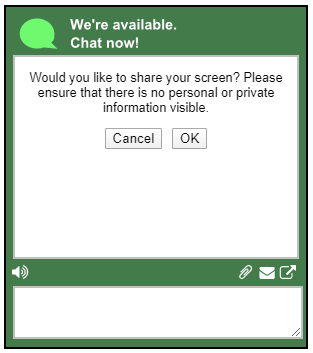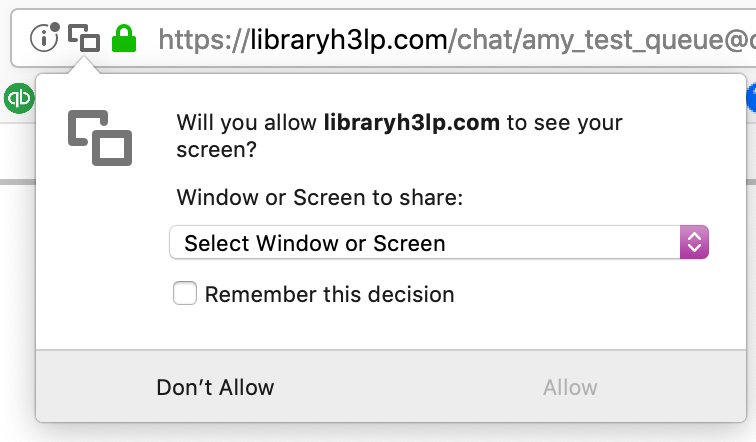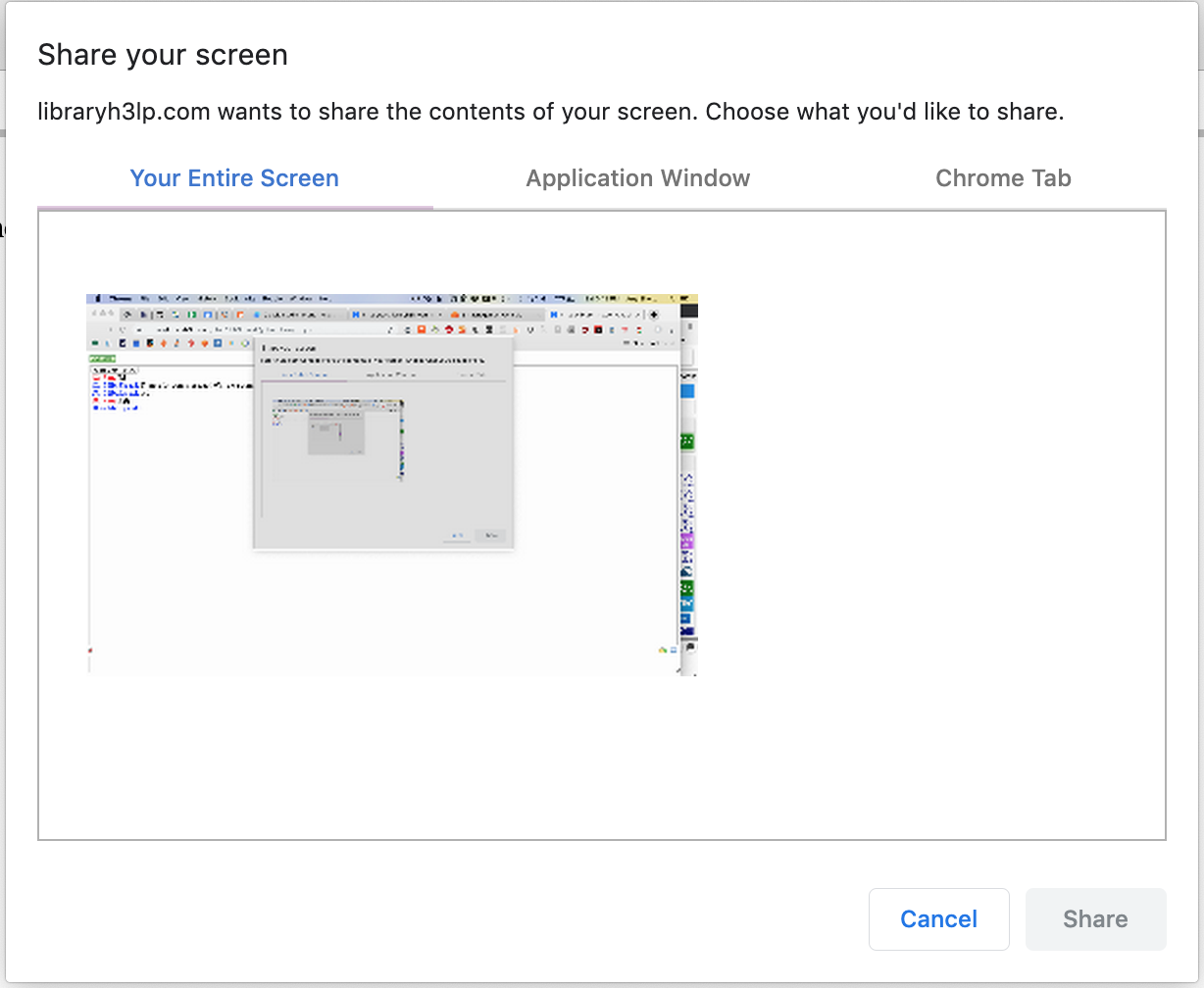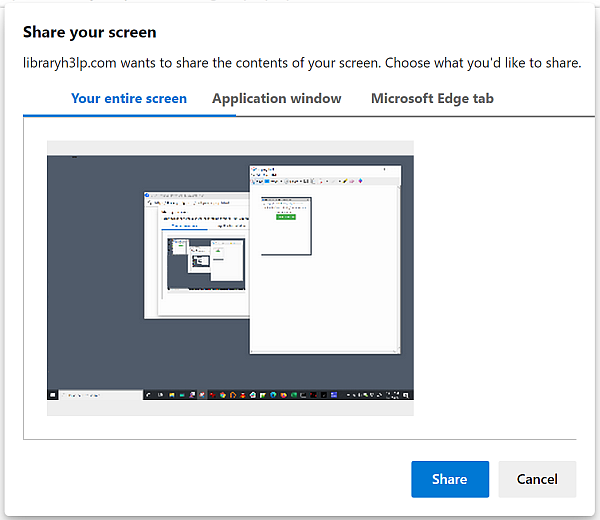Want to build your own 24/7 FAQ knowledge base?
LibraryH3lp subscriptions
include unlimited independent internal or public-facing
knowledge bases.
Search the LibraryH3lp Knowledge Base
Does chat include a screenshare or cobrowse feature?
9528 views | Last updated on Nov 06, 2025 screen sharing
During a chat, you can view the guest's screen in real-time when the guest is in a supported web browser (see the "Screensharing Limitations" section below) and if the chat box is https. The guest needs to explicitly grant permissions on their side to allow you to view their screen through a series of deliberate actions in the browser. The guest cannot view your (the operator's) screen, and the guest cannot initiate screensharing. At present, there is no sound with screensharing.
Screensharing is part of the Sharing Tool and works in tandem with snapshots. At any time while viewing the guest's screen, you can grab a snapshot of the screen, take it into the snapshot editor to crop and/or mark it up, and then send the revised version back to the guest. You can literally indicate, please click HERE! Because sometimes a picture can be worth a thousand words.
Neither the guest nor the operator is required to download anything special (like extensions or plugins) to use the Sharing Tool. All that is needed is a modern web browser.
Browsers
Screensharing relies on new kinds of APIs recently built into most modern web browsers.
- The guest has to be using Chrome 72+, Firefox, Safari 13+, or Edge 81+ (download). The guest also needs to be using a secure (https) chat box, but chances are pretty good that your chat boxes are all https by now.
- The operator (you) has to be using Chrome 72+, Firefox, Safari 11+, or Edge 81+ (download).
Inviting the Guest to Share their Screen
Screensharing is kicked off by the chat operator with an invite to the guest, which you can customize to suit.

There is absolutely no way you can spy on a guest without explicit permission (and a sequence of several deliberate mouse clicks to grant that permission) from the guest. And you cannot accidentally initiate screensharing because it has taken a sequence of several deliberate mouse clicks to get to this point.
Guest's view of screensharing invitation
The guest receives the invitation within their chat box and then has to explicitly allow you to access to their screen using the mechanisms in their web browser and operating system. Mac users will have to complete a one-time permission step that grants their web browser permission to screen share, if they have not already authorized this kind of access.
Here is what the guest will see in their chat box when initially invited:

Embedded chat box only
If the guest is using an embedded chat box, there will be another prompt to share, and selecting "start sharing" will take the user to the next step. This "start sharing" step is not present if the guest is using a pop-out or follow-me chat box.

Web browser: what do you want to share?
The guest's web browser will then prompt the guest to select how much of their screen they want to share. Unless the guest is using Safari, then there is no choice since Safari only shares the entire screen.
In browsers other than Safari, the guest can share their entire screen, a single application, or even a single web browser tab. If the guest has multiple monitors, they will also need to select the desired monitor. Once the guest has made their decision and selected what they want to share, the web browser will allow the sharing to proceed.
Firefox

Chrome

Edge

Safari

All web browsers except for Safari
NOTE: Except for Safari where the guest can only share the entire screen, the guest will have to make a selection (entire screen, application, tab) before the SHARE or ALLOW button will be enabled and clickable. The SHARE or ALLOW button will be greyed out until a selection is made.
Taking Snapshots during Screensharing
With the toolbar above your view of the guest's screen, the chat operator can zoom, take snapshots of the guest's screen, or end screensharing. When you take snapshots of the guest's screen, you can mark them up and send them to the guest. Learn more about snapshots.

Screensharing Limitations
Extensions that interfere with WebRTC
If there are extensions/plugins installed in the browser used by either the operator or the guest that impact WebRTC or that are designed to hide your IP (IP leak tools), that will prevent screensharing success since native browser screensharing relies on WebRTC which needs to know an IP address for both operator and guest. Some examples of such extensions/plugins are uBlock Origin, WebRTC Leak Prevent, WebRTC Control, Easy WebRTC Block, and WebRTC Leak Checker.
Networks and Networking
- Same internal network or proxy server
We've seen screensharing fail when both operator and guest are on the same network or behind the same proxy, likely because the individual computer IPs for guest and operator are not resolved properly. Reasons vary, so it is best to check with local IT about anything affecting WebRTC or the visibility of the IP address. - VPNs
Screensharing will not work if either the operator or the guest is using a VPN. This is because WebRTC needs to know the IP address for both parties and many VPNs will hide your IP address. - Mobile Hot Spots
Screensharing will not work on mobile hotspots if your IP is hidden by an IP leak tool. - Firewalls
Screensharing will not work if there is a firewall that is configured to prevent IP leaks on either the operator or guest side.
Mobile Devices
Screensharing will not work is the guest is chatting from a mobile device (i.e. phone or tablet).
Test Environments - When you are testing screensharing by yourself
- Chrome: You cannot be both guest and operator in Chrome on the same computer.
FAQ URL:
